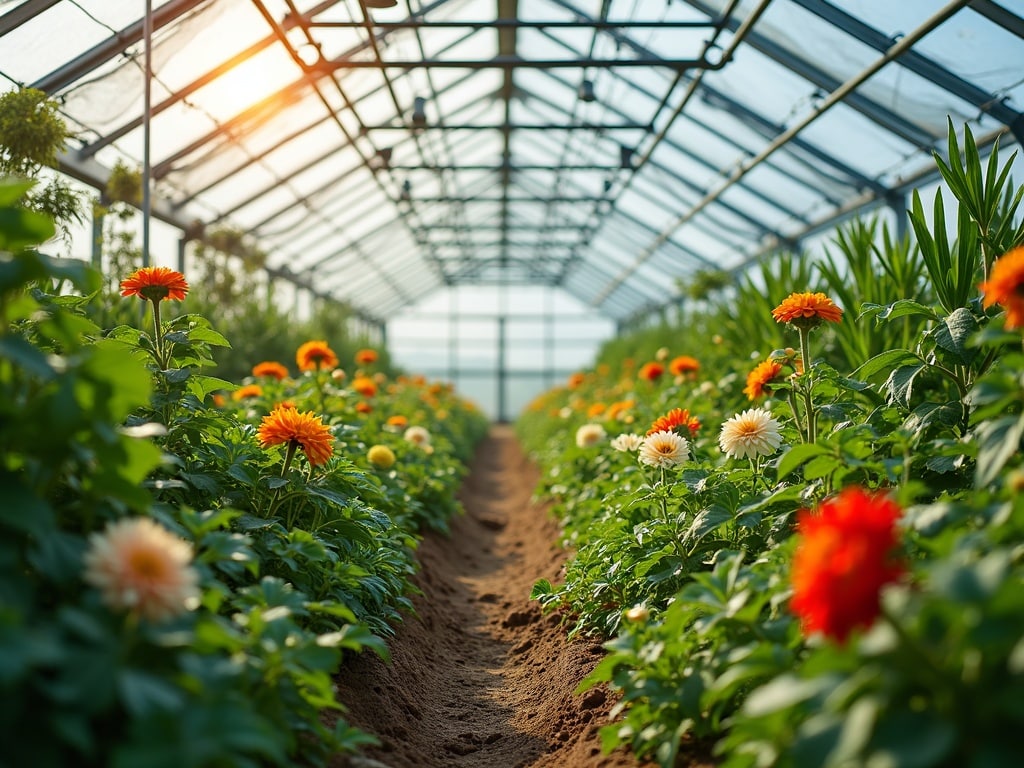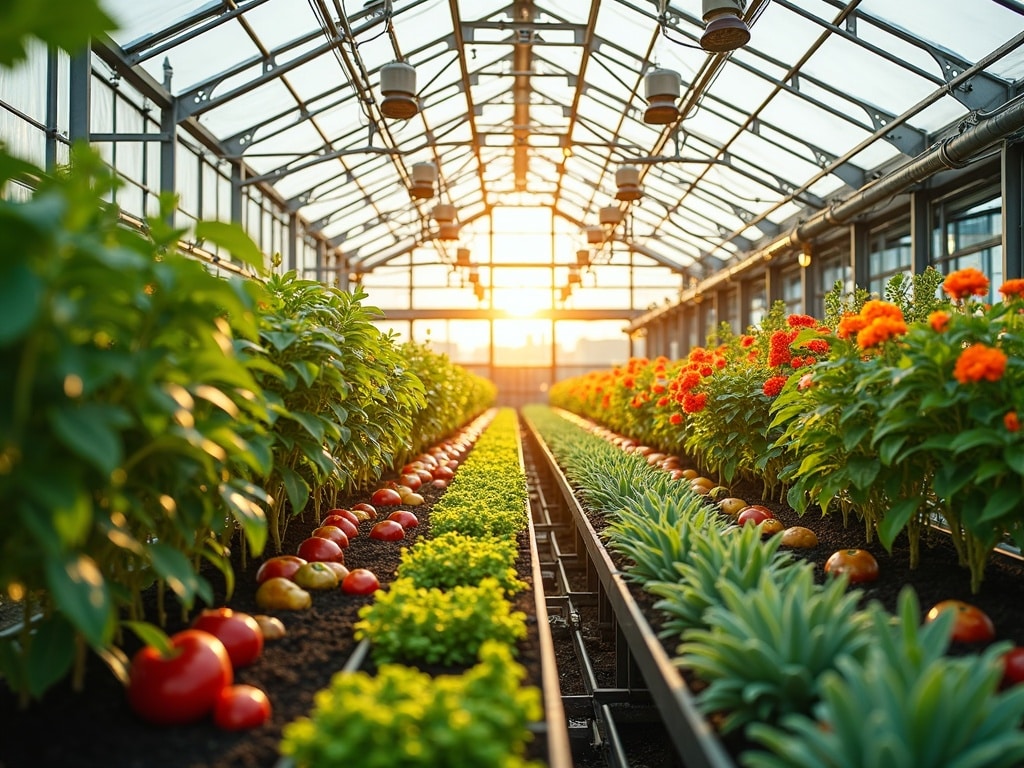Summer Greenhouse Management: A Comprehensive Guide to Thriving Plants
Imagine stepping into your greenhouse on a sweltering summer day, expecting to find a lush, vibrant oasis, only to be greeted by wilting leaves and stressed plants. The summer heat can transform a greenhouse from a nurturing environment into a challenging one. But fear not! With the right strategies, you can effectively manage your greenhouse during the summer months and ensure your plants thrive.
Understanding the Challenges of Summer Greenhouse Growing
Summer presents unique challenges to greenhouse growers. High temperatures, intense sunlight, and increased humidity can create a stressful environment for plants, leading to various problems if not properly managed.
The Heat Factor
Excessive heat is the primary concern. Greenhouses, by design, trap heat, and summer temperatures can quickly soar to levels damaging to many plants. This can lead to:
- Heat stress: Plants struggle to photosynthesize efficiently, leading to reduced growth and yield.
- Wilting: Excessive water loss through transpiration causes leaves to droop and wilt.
- Sunscald: Intense sunlight can burn leaves and fruits, especially on sensitive plants.
Humidity's Double Edge
While some humidity is beneficial, excessive humidity can be detrimental.
- Disease: High humidity creates a breeding ground for fungal diseases like powdery mildew and botrytis.
- Poor pollination: Excess moisture can interfere with pollen dispersal and viability.
Light Intensity
While plants need light, too much can be harmful.
- Photoinhibition: Excessive light can damage the chlorophyll in leaves, reducing photosynthetic efficiency.
- Bleaching: Pigments in flowers and fruits can fade or bleach under intense sunlight.
Ventilation: The Cornerstone of Summer Greenhouse Cooling
Effective ventilation is crucial for maintaining optimal temperatures and reducing humidity inside the greenhouse. It involves exchanging the hot, stagnant air inside with cooler, fresher air from outside.
Natural Ventilation Strategies
Natural ventilation relies on the natural movement of air to cool the greenhouse.
- Roof Vents: These are the most effective for releasing hot air, as hot air rises.
- Side Vents: Positioned along the sides of the greenhouse, they allow cooler air to enter.
- Roll-Up Sides: Offer maximum ventilation by opening up large sections of the greenhouse walls.
Optimizing Natural Ventilation:
Placement: Position vents to take advantage of prevailing winds.
Size: Ensure vents are adequately sized to provide sufficient airflow. A general rule of thumb is that the vent area should be at least 20% of the floor area of the greenhouse.
Automated Vent Openers: Thermostatically controlled vent openers automatically adjust vent positions based on temperature, providing consistent and efficient ventilation.
Mechanical Ventilation Systems
When natural ventilation is insufficient, mechanical ventilation systems are necessary.
- Exhaust Fans: These fans draw hot air out of the greenhouse, creating negative pressure that pulls in cooler air through vents or openings.
- Circulation Fans: These fans circulate air within the greenhouse, preventing temperature stratification and reducing humidity pockets.
- Evaporative Coolers (Swamp Coolers): These coolers draw air through wet pads, cooling the air through evaporation. They are effective in dry climates but less so in humid regions.
Sizing and Placement of Fans:
Exhaust Fan Capacity: Calculate the required airflow based on the greenhouse volume and desired air exchange rate. A common recommendation is an air exchange rate of 1-2 times per minute.
Number of Fans: Distribute fans evenly to ensure uniform airflow throughout the greenhouse.
Placement: Position exhaust fans high in the greenhouse to remove the hottest air. Place intake vents or fans low to bring in cooler air. Circulation fans should be positioned to create a circular airflow pattern.
Shading: Taming the Sun's Intensity
Shading reduces the amount of sunlight entering the greenhouse, preventing overheating and protecting plants from sunscald.
Shade Cloth
Shade cloth is a woven fabric designed to block a percentage of sunlight. It comes in various densities, allowing you to customize the amount of shading based on your plants' needs.
- Material: Common materials include polyethylene, polypropylene, and aluminized fabrics. Aluminized shade cloth reflects more sunlight and provides better cooling.
- Density: Choose the appropriate shade cloth density based on the light requirements of your plants. Vegetables like tomatoes and peppers typically need 30-50% shade, while shade-loving plants like orchids may require 70-90% shade.
- Installation: Shade cloth can be installed inside or outside the greenhouse. External installation is more effective at blocking heat before it enters the greenhouse.
Whitewash
Whitewash is a liquid coating applied to the greenhouse glazing to reflect sunlight.
- Application: Whitewash is typically applied with a sprayer or brush. It is important to apply an even coat to ensure uniform shading.
- Removal: Whitewash can be removed with water and a brush at the end of the summer.
- Adjustability: The amount of shading can be adjusted by varying the concentration of the whitewash.
Other Shading Methods
- Roll-Up Shades: Allow you to adjust the amount of shading as needed throughout the day.
- Internal Shading Systems: Automated systems that deploy shade curtains based on temperature and light levels.
Humidity Control: Preventing Disease and Optimizing Growth
Managing humidity is critical for preventing diseases and ensuring optimal plant growth.
Dehumidification
Removing excess moisture from the air.
- Ventilation: Introducing drier outside air helps to lower humidity levels.
- Dehumidifiers: Electrical appliances that remove moisture from the air. They are effective but can be energy-intensive.
- Air Circulation: Fans help to prevent humidity pockets and promote evaporation.
- Spacing: Proper plant spacing allows for better air circulation, reducing humidity around the plants.
Watering Practices
How you water your plants significantly impacts humidity levels.
- Timing: Water in the morning to allow foliage to dry before nightfall, reducing the risk of fungal diseases.
- Method: Use drip irrigation or soaker hoses to deliver water directly to the roots, minimizing evaporation and reducing humidity. Avoid overhead watering.
Monitoring Humidity Levels
Use a hygrometer to monitor humidity levels and adjust your management practices accordingly. Aim for a relative humidity of 60-80% for most plants.
Watering and Irrigation Strategies for Summer
Proper watering is essential to keep plants hydrated and healthy during the hot summer months.
Assessing Watering Needs
Soil Moisture: Check the soil moisture regularly by feeling the soil or using a soil moisture meter.
Plant Appearance: Look for signs of wilting or leaf discoloration, which can indicate water stress.
Weather Conditions: Adjust watering frequency based on temperature, humidity, and sunlight intensity.
Efficient Irrigation Techniques
Drip Irrigation: Delivers water directly to the roots, minimizing water loss through evaporation and reducing weed growth.
Soaker Hoses: Similar to drip irrigation, but use porous hoses that weep water slowly into the soil.
Automated Irrigation Systems: Use timers or sensors to automatically water plants based on their needs.
Water Quality
Ensure the water you use for irrigation is of good quality.
pH: Test the pH of the water and adjust it if necessary. Most plants prefer a pH of 6.0-7.0.
Salinity: High salt levels can damage plants. If your water has high salinity, consider using rainwater or reverse osmosis water.
Nutrient Management in the Summer Greenhouse
Plants require adequate nutrients to thrive, especially during the active growing season.
Fertilizer Selection
Balanced Fertilizer: Use a balanced fertilizer that contains nitrogen, phosphorus, and potassium, as well as micronutrients.
Slow-Release Fertilizer: Provides a steady supply of nutrients over time, reducing the need for frequent applications.
Liquid Fertilizer: Allows for precise nutrient control and can be applied through irrigation systems.
Fertilization Frequency
Adjust fertilization frequency based on plant needs and growth rate.
Regular Feeding: Feed plants regularly during the growing season, but reduce or stop feeding during periods of dormancy.
Foliar Feeding: Apply nutrients directly to the leaves for rapid absorption.
Monitoring Nutrient Levels
Soil Testing: Regularly test the soil to determine nutrient levels and adjust fertilization accordingly.
Plant Tissue Analysis: Analyze plant tissue to identify nutrient deficiencies.
Pest and Disease Control in Summer
The warm, humid conditions of summer can create a favorable environment for pests and diseases.
Prevention Strategies
Sanitation: Keep the greenhouse clean and free of debris to reduce pest and disease habitat.
Ventilation: Proper ventilation helps to reduce humidity and prevent fungal diseases.
Weed Control: Remove weeds from the greenhouse and surrounding areas to prevent them from harboring pests and diseases.
Resistant Varieties: Choose plant varieties that are resistant to common pests and diseases.
Monitoring for Pests and Diseases
Regular Inspections: Inspect plants regularly for signs of pests or diseases.
Sticky Traps: Use yellow or blue sticky traps to monitor for flying insects.
Magnifying Glass: Use a magnifying glass to examine plants for small pests like spider mites.
Control Methods
Biological Control: Use beneficial insects or microorganisms to control pests.
Insecticidal Soap: Effective against soft-bodied insects like aphids and spider mites.
Neem Oil: A broad-spectrum insecticide and fungicide derived from the neem tree.
Fungicides: Use fungicides to control fungal diseases. Choose products that are safe for use in greenhouses and follow label instructions carefully.
Crop Selection for Summer Greenhouses
Choosing the right crops is essential for successful summer greenhouse growing. Opt for heat-tolerant varieties that can withstand the summer heat.
Vegetables
Tomatoes: Choose heat-tolerant varieties like ‘Florida 91' or ‘Solar Fire'.
Peppers: Bell peppers, chili peppers, and other pepper varieties thrive in warm conditions.
Cucumbers: Select parthenocarpic varieties that don't require pollination.
Flowers
Zinnias: Heat-loving flowers that come in a variety of colors.
Marigolds: Easy-to-grow flowers that attract beneficial insects.
Geraniums: Drought-tolerant flowers that bloom throughout the summer.
Herbs
Basil: Thrives in warm conditions and can be harvested regularly.
Mint: Grows quickly and can be used in teas and other beverages.
Rosemary: Drought-tolerant herb that adds flavor to many dishes.
Optimizing Greenhouse Design for Summer
Certain design features can help to improve summer greenhouse management.
Greenhouse Orientation
Orient the greenhouse along an east-west axis to minimize the amount of direct sunlight exposure during the hottest part of the day.
Glazing Materials
Choose glazing materials that offer good light transmission but also reduce heat buildup.
Polycarbonate: Offers good insulation and impact resistance.
Acrylic: Similar to polycarbonate but with better light transmission.
Glass: Provides excellent light transmission but can be expensive and fragile.
High Roofs
A high roof allows for better air circulation and reduces heat buildup.
Essential Tools for Summer Greenhouse Management
Having the right tools can make summer greenhouse management easier and more efficient.
- Thermometer/Hygrometer: To monitor temperature and humidity levels.
- Soil Moisture Meter: To check soil moisture levels.
- Shade Cloth or Whitewash: To reduce sunlight intensity.
- Ventilation System: To provide adequate airflow.
- Irrigation System: To water plants efficiently.
- Sprayer: To apply fertilizers, pesticides, and fungicides.
Troubleshooting Common Summer Greenhouse Problems
Even with the best management practices, problems can still arise. Here's how to troubleshoot some common issues.
Overheating
Symptom: Wilting leaves, stunted growth.
Solution: Increase ventilation, install shade cloth, water plants more frequently.
High Humidity
Symptom: Fungal diseases, poor pollination.
Solution: Increase ventilation, use a dehumidifier, space plants properly.
Pest Infestations
Symptom: Damaged leaves, visible pests.
Solution: Use biological control methods, insecticidal soap, or neem oil.
Nutrient Deficiencies
Symptom: Yellowing leaves, stunted growth.
Solution: Test soil and apply appropriate fertilizer.
Automating Summer Greenhouse Management
Automation can help to streamline greenhouse management and ensure consistent conditions.
Automated Ventilation Systems
Automatically adjust vent positions based on temperature.
Automated Irrigation Systems
Water plants based on soil moisture levels or time intervals.
Automated Shading Systems
Deploy shade curtains based on light intensity.
Environmental Control Systems
Integrate all greenhouse systems into a central control system for automated management.
The Future of Summer Greenhouse Management
Innovations in technology and sustainable practices are shaping the future of summer greenhouse management.
LED Lighting
Provides efficient and customizable lighting for plant growth.
Hydroponics and Aquaponics
Soilless growing methods that can be used to optimize plant growth and water use.
Sustainable Practices
Reducing energy consumption and minimizing environmental impact through efficient irrigation, renewable energy, and waste reduction.
With a proactive approach and a commitment to understanding your plants' needs, you can successfully navigate the challenges of summer greenhouse management and enjoy a bountiful harvest. Embrace these strategies, adapt them to your specific greenhouse environment, and watch your plants flourish even in the heat of summer.


